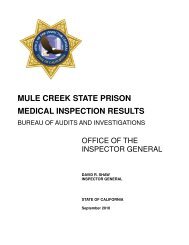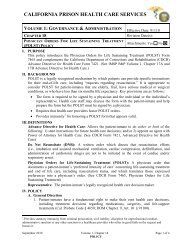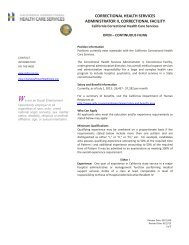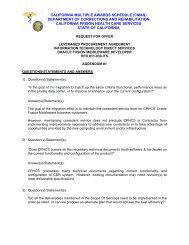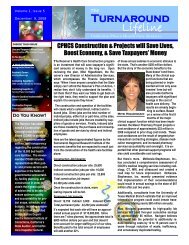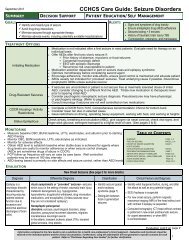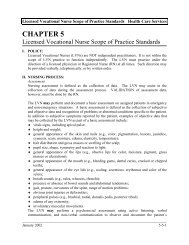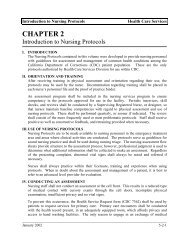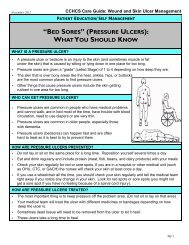Addendum 2 to RFP, Temporary/Relief On-Site Nursing Services, 10 ...
Addendum 2 to RFP, Temporary/Relief On-Site Nursing Services, 10 ...
Addendum 2 to RFP, Temporary/Relief On-Site Nursing Services, 10 ...
You also want an ePaper? Increase the reach of your titles
YUMPU automatically turns print PDFs into web optimized ePapers that Google loves.
STATE OF CALIFORNIAPRISON HEALTH CARE SERVICES3701 North Freeway Blvd, Sacramen<strong>to</strong>, CA 95834P.O. Box 4038, Suite 3701, 95812-4038J. Clark Kelso, ReceiverOc<strong>to</strong>ber 22, 2009TO: PROSPECTIVE BIDDERRE: REQUEST FOR PROPOSAL (<strong>RFP</strong>) 090341, ADDENDUM NUMBER 2CPHCS has attached responses <strong>to</strong> a portion of the questions that have been broughtforth by potential contrac<strong>to</strong>rs. Please note, there are additional questions pending aresponse, and they will be addressed in a subsequent addendum(s)If you have any questions or need assistance from this office, please do not hesitate <strong>to</strong>contact Debra Jones at (916) 648-8235 or debra.jones@cdcr.ca.gov.
Responses <strong>to</strong> Vendor QuestionsRequest for ProposalsFor <strong>Temporary</strong>/<strong>Relief</strong> <strong>On</strong>-<strong>Site</strong> <strong>Nursing</strong> <strong>Services</strong>(Registered Nurse, Licensed Vocational Nurse and Certified <strong>Nursing</strong> AssistantCalifornia Adult Prison Facilities<strong>RFP</strong> Number 09341<strong>Addendum</strong> #2Please note, there are additional questions pending a response, and they will be addressed in a subsequentaddendum(s)1. What is the purpose of the <strong>RFP</strong>’s 975 hour per year limit on assignment of each registry employee?The purpose of the 975-hour limit is <strong>to</strong> strengthen the state’s ability <strong>to</strong> recruit and retain a civil serviceworkforce. We believe building a strong civil service workforce will lead <strong>to</strong> greater continuity of careand high quality, cost effective service. However, allowing individuals <strong>to</strong> serve in long term contractpositions, at rates or pay well above civil service salaries, weakens the State’s ability <strong>to</strong> recruit andretain civil service employees. We recognize that registry staffing is a critical <strong>to</strong>ol available <strong>to</strong> theState. But it is meant <strong>to</strong> supplement, and not supplant, the civil service workforce.2. Is the <strong>RFP</strong> in effect requiring that all registries treat their temporary workers as “employees”, and not“independent contrac<strong>to</strong>rs”? Does the <strong>RFP</strong> mandate that the registries provide worker’s compensationcoverage, not just for their administrative personnel, but for their temporary/relief workers as well?CDCR/CPHCS defers <strong>to</strong> the registry <strong>to</strong> determine its relationship with its nurses (e.g., staffing viaindependent contracts, direct employment of staff, or other arrangements). However, CDCR’s contractis with the registry—not the individual providers. Thus, CDCR/CPHCS relies on and requires theregistry <strong>to</strong> ensure that it and its nurses comply with all applicable laws and contractual obligations.This requirement includes that the registry ensure that it and its nurses comply with applicableworker’s compensation laws, whatever they may be.3. How will CDCR/CPHCS enforce the 975-hour limit?The contract provisions require the successful contrac<strong>to</strong>r <strong>to</strong> comply with and enforce the limit.CDCR/CPHCS staff will moni<strong>to</strong>r compliance through reports submitted by the contrac<strong>to</strong>r.4. What will the penalty be for a violation of the 975-hour limit?The registry is responsible for tracking the number of each staff person’s hours worked for the state bystaff, including any previously worked hours for another registry. If a registry staff person exceeds thehourly cap, the hours worked in excess of the hourly cap may not be reimbursed, as it would be aviolation of the terms of the contract.5. What will occur when nurses who have been withdrawn from service due <strong>to</strong> the 975-hour cap areeligible <strong>to</strong> return <strong>to</strong> service? Will they be given priority? Will they be subject <strong>to</strong> gate clearancerequirements again? Will they be required <strong>to</strong> go through orientation if they have not worked in 6months?A. The staff of the registries are not employees or contrac<strong>to</strong>rs of the State of California and are notentitled <strong>to</strong> any return rights. In addition, registry staff will have no priority when returning <strong>to</strong>service following year or years in which they reached the 975-hour cap. The registry—not theState of California—will make placement decisions for staff members that are eligible forplacement.B. The requirement for Gate Clearance is the policy of CDCR, which requires contract providers <strong>to</strong>be reevaluated and cleared on a yearly basis.
Responses <strong>to</strong> Vendor QuestionsRequest for ProposalsFor <strong>Temporary</strong>/<strong>Relief</strong> <strong>On</strong>-<strong>Site</strong> <strong>Nursing</strong> <strong>Services</strong>(Registered Nurse, Licensed Vocational Nurse and Certified <strong>Nursing</strong> AssistantCalifornia Adult Prison Facilities<strong>RFP</strong> Number 09341<strong>Addendum</strong> #2Please note, there are additional questions pending a response, and they will be addressed in a subsequentaddendum(s)C. Registry staff returning after a hiatus will be required <strong>to</strong> attend an orientation. New policy orprocedures will likely <strong>to</strong> have been developed so it would be critical that any registry staff bebrought up <strong>to</strong> date on any new or changed policies or procedures.6. If a nurse makes an unemployment insurance claim, where will responsibility for defense of that claimrest?A registry nurse or other provider is not an employee or contrac<strong>to</strong>r of the State of California. Theregistry—not the State of California—will maintain the legal relationship with the nurse or otherprovider, whatever that relationship may be. The defense of any unemployment insurance or similarclaim would be the responsibility of the registry.7. At the end of a worker’s 975 hours, will the registry be able <strong>to</strong> replace the worker without “losing” theposition?If a registry employee exceeds the 975 hours and is no longer eligible <strong>to</strong> continue working at theCDCR/CPHCS institution there are no guarantees that the same registry company the employee worksfor is au<strong>to</strong>matically awarded the right <strong>to</strong> fill the position if services are still needed. Therefore, theproper procedure would be for the CDCR/CPHCS Institution Staff <strong>to</strong> refer back <strong>to</strong> the hierarchy matrixand begin contacting the registries, following the matrix.8. Do county jobs count <strong>to</strong>ward the 975 limit? What about work done for a state agency where theworker worked in a different capacity than that <strong>to</strong> which he or she is assigned (i.e. an LVN who didclerical work for the California Department of Mo<strong>to</strong>r Vehicles)?The 975-hour cap only applies <strong>to</strong> registry staffing who have performed services working for the CDCRor another State agency or entity during the same fiscal year that services are <strong>to</strong> be performed forCDCR/CPHCS. Any type of services performed, for any State agency or entity, within the same fiscalyear would count <strong>to</strong>ward the cap. <strong>Services</strong> performed for a county would not count <strong>to</strong>ward the cap.9. Will contrac<strong>to</strong>rs be required <strong>to</strong> provide all of the information on the reporting forms, and how will thisinformation be communicated?The original form was a draft and all information requested on the reporting form will be based on typeof service performed and modified <strong>to</strong> reflect that type of service reporting. All information beingrequested on the reporting form is information that a registry should be tracking. The form wasoriginally based on Temp/<strong>Relief</strong> <strong>On</strong>-<strong>Site</strong> Physician <strong>Services</strong>, which included some reportingrequirements they track that <strong>Nursing</strong> <strong>Services</strong> would not.<strong>10</strong>. We typically search for and respond <strong>to</strong> CPHCS’ <strong>RFP</strong>s using BidSynch, however the BidSynch systemwas not utilized for this request. Why?The advertising and posting of the <strong>RFP</strong> was conducted using direct solicitation, posting on the CPHCSwebsite and use of an alternate internet <strong>RFP</strong> clearinghouse. CPHCS has used this alternativecontracting procedure in the past under federal court orders issued in Plata v. Schwarzenegger.
Responses <strong>to</strong> Vendor QuestionsRequest for ProposalsFor <strong>Temporary</strong>/<strong>Relief</strong> <strong>On</strong>-<strong>Site</strong> <strong>Nursing</strong> <strong>Services</strong>(Registered Nurse, Licensed Vocational Nurse and Certified <strong>Nursing</strong> AssistantCalifornia Adult Prison Facilities<strong>RFP</strong> Number 09341<strong>Addendum</strong> #2Please note, there are additional questions pending a response, and they will be addressed in a subsequentaddendum(s)11. Is it permissible <strong>to</strong> communicate directly with the Receiver regarding concerns involving the content ofthe <strong>RFP</strong>?Under the <strong>RFP</strong>, the Receiver makes the final selection of registries. Therefore, communicationbetween any registry and the Receiver during the procurement process would be inappropriate.



